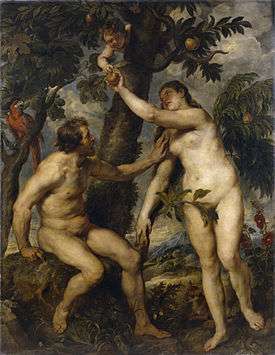The Fall of Man (Rubens)

The Fall of Man, Adam and Eve or Adam and Eve in the earthly paradise is a 1628-1629 painting by Rubens, now in the Prado in Madrid. Once attributed to the minor Dutch artist Karel van Mander, it is now recognised as a work by Rubens.
It is a copy of the painting of the same subject by Titian,[1] seen by Rubens during his 1628-1629 trip to Madrid for peace negotiations to end the Dutch Revolt. It reflects Raphael's influence on Titian and Jan Brueghel the Elder's influence on Rubens, who adds a parrot and changes Adam's posture, musculature, age and expression.[2]
 Version by Titian, c. 1550
Version by Titian, c. 1550
References
- ↑ "Titian catalogue entry". Museodelprado.es. 2009-09-15. Retrieved 2013-08-07.
- ↑ "Rubens catalogue entry". Museodelprado.es. 2009-09-15. Retrieved 2013-08-07.
This article is issued from Wikipedia - version of the 8/3/2016. The text is available under the Creative Commons Attribution/Share Alike but additional terms may apply for the media files.
